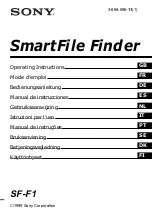
Chapter
3
Operating Instructions
CLX490 Compact OMNI Scanner
3-4
©
SICK AG · Division Auto Ident · Germany · All rights reserved
8009237/RB47/2007-08-03
Product description
3.2
Method of operation
The CLX first scans the bar code with a folded scan line (resulting in a cross) and then de-
codes it. The data is forwarded via the main data interface (serial host interface) to a host/
PC for further processing. An overview of the CLX functions is provided in
The CLX is equipped with two decoders:
•
The SMART decoder (
S
ICK
M
odular
A
dvanced
R
ecognition
T
echnology) for decoding
bar codes with small code height, bar codes that are dirty or damaged, as well as bar
codes that are tilted excessively (azimuth angle)
•
The tried-and-tested standard decoder of the CLV series
The CLX derives useful diagnosis data from the reading process and can transfer it also to
the host. It also records operating data that can be interrogated at any time. The quality of
the read can be checked in percentage evaluation mode.
To start the reading process when an object is located in the reading field, the CLX requires
a suitable trigger. This opens an internal time window ("reading interval") in the CLX. In the
default configuration, this trigger is supplied by an external reading pulse sensor. Alternative
trigger sources include free-running mode or a command via the host interface (for more
complex applications: OTC trigger).
With small object distances (object distance < reading gate length) the bar code has to be
allocated to the right object with the help of the internal tracking of the CLX.
The current operating status is indicated by four LEDs.
If the trigger is supplied externally, the "Sensor" switching input instructs the CLX to start the
reading process. The five "IN 0 to IN 4" switching inputs switch the focus position in
response to certain events, as an alternative to the autofocus function. The "IN 4” input can
also be assigned to special functions. The four "Result 1 to Result 4" switching outputs can
be assigned to different functions alternativly for displaying the result status and also control
external devices, such as a PLC.
The CLX is operated and configured via the auxiliary interface (serial auxiliary interface) using
the CLV-Setup software or via the host interface/auxiliary interface using command strings.
System, warning, and error messages help you configure the device and locate the source
of errors during startup and reading mode.
Fig. 3-2:
Block diagram: CLX functions
"Sensor"
"IN 0"
"IN 1"
"IN 2"
"IN 3"
"IN 4"
"Result 1"
"Host"
"Terminal"
"Result 2"
"Result 3"
"Result 4"
Scanner
Decoder
Interface
V
S
Photoelectric
switch
Reading pulse
Signal
1)
Focal control
Conveyer increment
1) if requered
PC
Operation
Parameterization,
etc.
HOST
Further processing
of the reading result
Status display
e. g. Device Ready
e. g. Good Read
e. g. No Read
e. g. Match 1
CLX490
















































